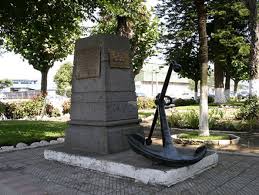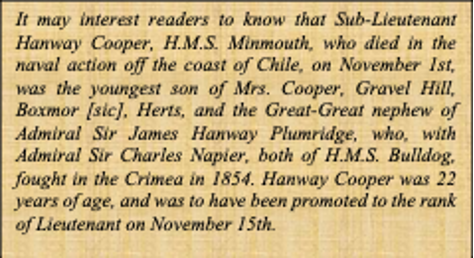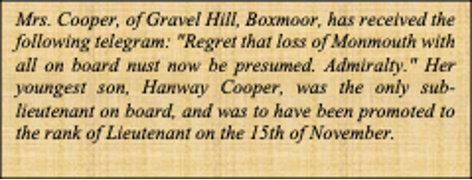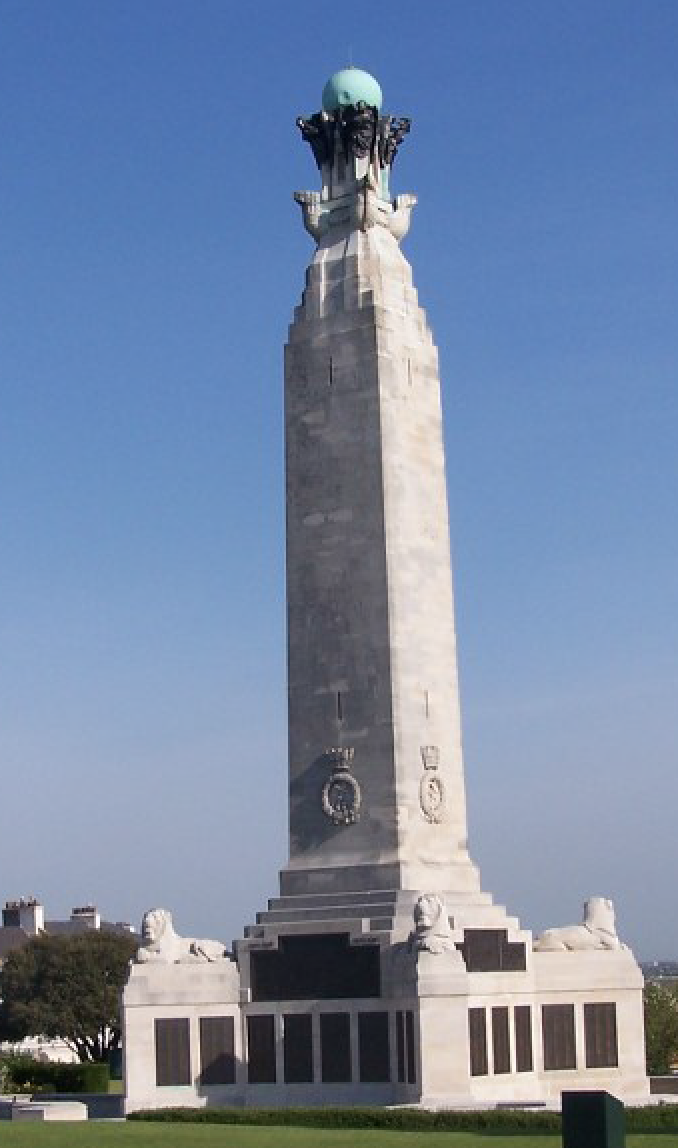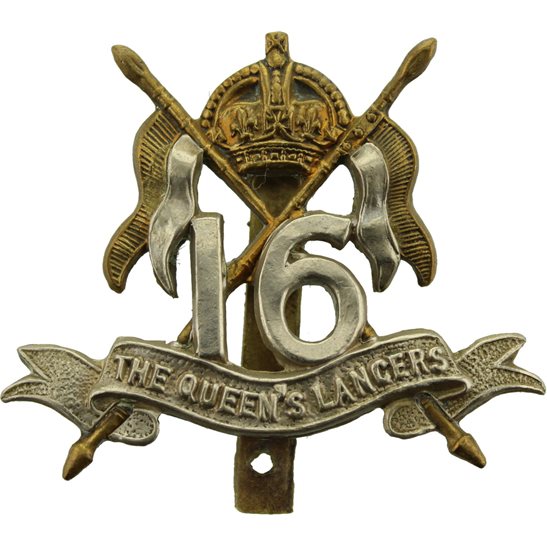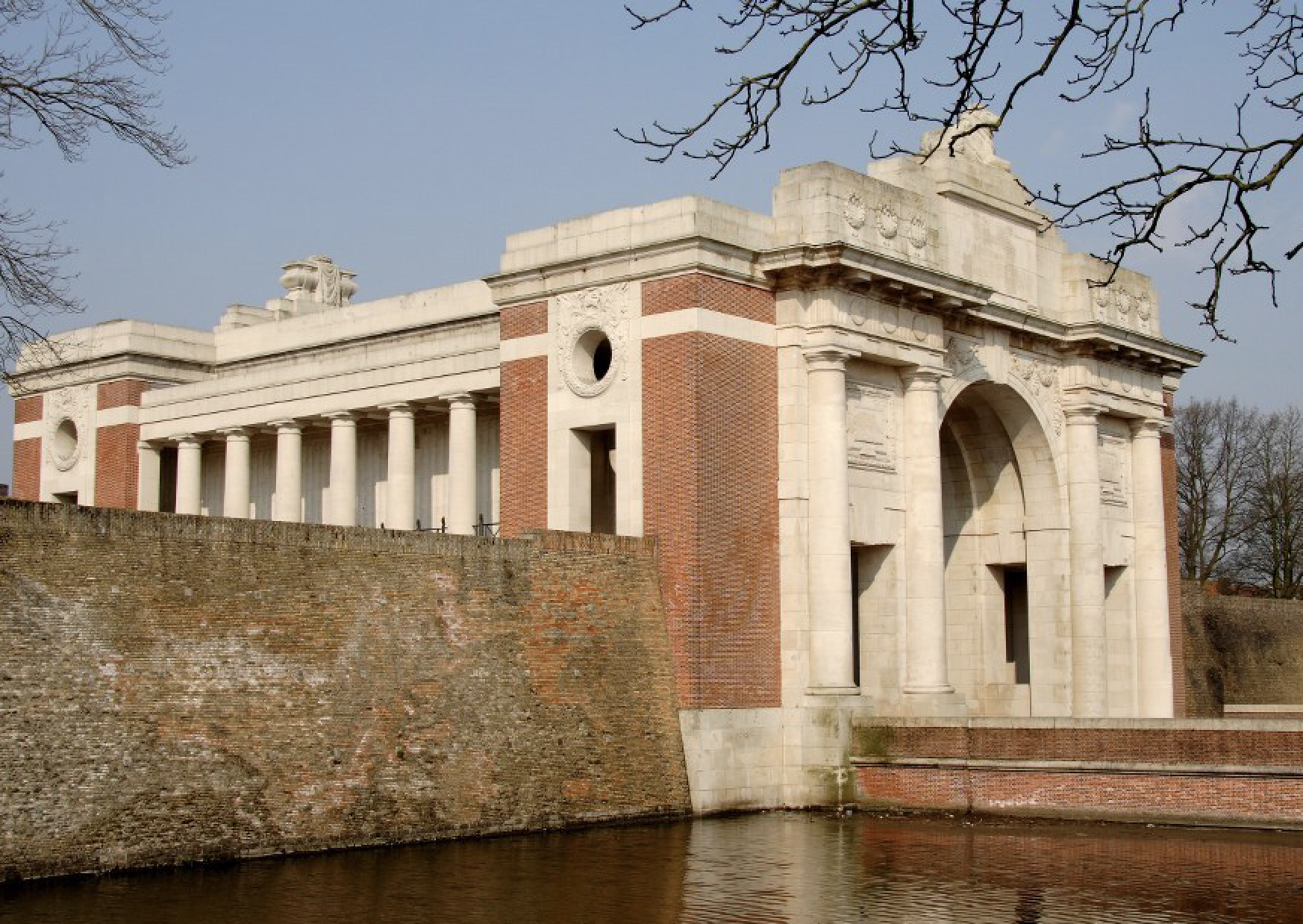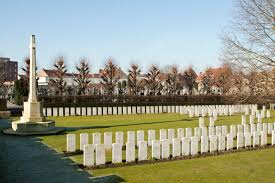Fallen in November 1914:
Hanway Cooper
Richard Sturdy
Humfrey Talbot
HANWAY COOPER
Sub-Lieutenant
HMS “Monmouth” Royal Navy
Killed in Action Sunday, 1st November 1914
Remembered with Honour, Plymouth Naval Memorial, Hampshire, United Kingdom, Panel 1
Hanway Cooper was born on 2nd May 1892 in Hampstead, the third son and youngest child of William and Marion Cooper. His older siblings were William, Arthur and Dorothy and when Hanway was born, the family were living at 37 Netherhall Gardens, a substantial property in affluent Hampstead in London.
By 1911 Hanway’s mother and sister
are recorded living at ‘Springfield’, Gravel Hill in Boxmoor, whilst his father
William was in the United States of America where he died in 1913 in Washington
DC.
Hanway was from an illustrious
naval family and he was named for his great-great uncle, Admiral Sir James Hanway
Plumridge who had fought in the Crimean War in 1854. (see extract)
Hanway was educated at St Christopher’s School in Eastbourne before entering the Royal Naval College, Osborne on 12th January 1905. Osborne had been Queen Victoria’s summer residence and following her death, it became a junior officer training college for the Royal Navy in 1903. Hanway was amongst the earliest intake and started his naval training at thirteen remaining at Osborne for two years. Fellow alumnus included Edward VIII, George VI and George Archer-Shee who was expelled from Osborne after being falsely accused of stealing a five-shilling postal order, inspiring the play "The Winslow Boy".
From Osborne Hanway went to Britannia College, Dartmouth to continue his naval training. He was promoted Acting Sub-Lieutenant on 15th September 1912 and Sub-Lieutenant exactly two months later. Between 1909 and 1914, he served on many ships including; Commonwealth, Rattlesnake, Warrior, Pembroke and Shannon. His superiors reported; “a zealous hardworking officer”, “carried out the duties of executive officer with zeal and ability”, and “a very capable and promising officer”.
On the outbreak of war, he was appointed to HMS Monmouth, part of the British West Indies Squadron, in August 1914. Hanway’s time on active service was to be tragically short and he died with all hands when Monmouth was sunk off the coast of Chile at the Battle of Coronel on Sunday, 1st November 1914.
This was the first major naval battle of the War and is notable not only because it was Britain's first naval defeat of the Great War, but it was its first anywhere in the world in over a century, dating back to the war of 1812 against the United States. The Germans won a resounding victory, sinking two of the four British ships, Monmouth and Good Hope, with the loss of over 1,400 lives. Not a single German sailor died.
Rear-Admiral Sir Christopher Cradock commanded the
British West Indies Squadron and he understood
his orders were to fight to the end, despite the odds being heavily against him.
News of his death and the defeat shocked
Britain.
The sinking of Monmouth and Hanway’s death were reported in the Hemel Gazette in
November 1914 and included the content of the telegram received by his mother. (see extract)
Had he not been killed, Hanway would have been promoted Lieutenant on 15th November 1914.
Hanway is Remembered with Honour on
Plymouth Naval Memorial.
In 1989 a memorial to those who perished in the battle was erected in the 21st May Square at Coronel, Chile. Along with two plaques depicting HMS Good Hope and HMS Monmouth, it has a central dedication plaque in Spanish which reads
‘In memory of the 1,418 officers and sailors of the British military
squadron and their Commander-in-Chief, Rear Admiral Sir Christopher Cradock,
Royal Navy, who sacrificed their lives in the Naval Battle of Coronel, on 1
November 1914. The sea is their only grave.’
Hanway was 22 years old when he died.
He was eligible for the 1914-15 Star, the British War Medal and the Allied Victory Medal.
Battle of Coronel Memorial, Chile (Public Domain)
Sub-Lieutenant Hanway Cooper, Britannia College, Dartmouth c1909 (Courtesy: IWM, Bond of Sacrifice - First World War Portraits Collection)
Extract from the Hertfordshire, Hemel Hempstead Gazette and West Herts Advertiser, 28th Nov. 1914
"HMS Monmouth"
Extract from the Hertfordshire, Hemel Hempstead Gazette and West Herts Advertiser, 14th Nov. 1914
Plymouth Naval Memorial, Hampshire, United Kingdom (Courtesy: CWGC)
RICHARD STURDY
3092 Lance Corporal
16th (The Queen's) Lancers
Killed in Action Thursday, 5th November 1914
Remembered with Honour, Ypres (Menin Gate) Memorial, West-Vlaanderen, Belgium, Panel 5
Richard Sturdy was from Kent and he was born there in Seal near Sevenoaks in 1889 the third child of Richard and Rosa and their only boy. Richard had four sisters Rosa, Nellie, Lilly and the youngest Alice, who was born a year before their father died in 1896.
Richard’s mother Rosa was working as a domestic charwoman by 1901 to support her family and shortly afterwards met Joseph Ruby a servant at nearby ‘Wildernesse’, the home of the 2nd Baron Hillingdon, banker Charles Henry Mills.
Joseph and Ruby married in 1905 and moved to 17 Pullar Road, Boxmoor in 1907. By this time the young Richard had begun his apprenticeship as a butcher. He was to gain two additional siblings when his step-brothers Joseph and John were born in 1906 and 1908.
The 1911 Census records the Sturdy family living at 11 Fishery Cottages, Fishery Road, Boxmoor. It appears they are living in reduced circumstances as they occupy two rooms in this small cottage and share the accommodation with another family. Tragically, four other young men from this little row of cottages were killed in the Great War.
At this time Richard is boarding at 18 Queen Street,
Colchester and he is recorded as a regular soldier. He had given up the
butchery trade when he enlisted with the 16th (The Queen’s) Lancers
in Devizes, Wiltshire on 7th November 1910 shortly after his twenty-first birthday.
The 16th Lancers was part of the Household Cavalry and Cavalry of the Line assigned to the 3rd Cavalry Brigade. This brigade was a peacetime formation of the British Army, based in the Irish Command and at the outbreak of war it was at The Curragh in Ireland.
The ‘Scarlet Lancers’ as it was nicknamed would see action from August 1914 to the end of the Great War. Also of note during the war was the appointment of Field Marshal Sir William Robertson as Chief of the Imperial General Staff (CIGS). Robertson had joined the 16th Lancers as a Trooper and rose through the ranks of the Regiment to be a Troop Sergeant Major. He is the only enlisted soldier ever to have reached the rank of Field Marshal.
Richard disembarked in France with his Regiment on 17th August 1914 as part of 3rd Cavalry Brigade. The brigade took part in
many actions, notably the Battle of Mons and
the Battle of Le Cateau. In September 1914, it joined the formerly independent 5th Cavalry Brigade underBrigadier-General Hubert Gough and took part in the First Battle of the Aisne between the 12th and 15th September. Finally, Gough's Command was redesignated as 2nd Cavalry Division where It remained until the end of the war.
16th Queen's Lancers Cap Badge World War 1
Menin Gate Memorial, Ypres, West-Vlaanderen, Belgium (Courtesy: CWGC)
The division took part in the First Battle of Ypres, notably the battle of Gheluvelt and it was shortly after this engagement and during the build up to the Battle of Nonne Bosschen that Richard was killed. A series of German attacks on the Allied flanks from the 5th to the 9th November resulted in many casualties and it was on the first day of these attacks that Richard fell on Thursday, 5th November 1914.
He is Remembered with Honour on Ypres (Menin Gate) Memorial
Richard was 25 years old when he was killed in action.
He was eligible for the 1914-15 Star, the British War Medal and the Allied Victory Medal.
HUMFREY TALBOT
Lieutenant
3rd Dragoon Guards (Prince of Wales's Own)
Killed in Action Friday, 13th November 1914
Remembered with Honour, Ypres Town Cemetery, West-Vlaanderen, Belgium, Plot E1 3
Humfrey Talbot was the youngest son of Gustavus and Susan Talbot of Marchmont House, Hemel Hempstead. He was born on 11th September 1889 in Ceylon where his father was a member of the Legislative Council (the first form of representative government in the island) during the late 1880s. Humfrey had four older siblings; Reginald, Cecil-Emily, Constance and Gilbert and they were part of an illustrious family.
He was the grand-nephew of the 18th Earl of Shrewsbury and his father Gustavus, was the first Member of Parliament for Hemel Hempstead in 1918, as well as Mayor of the town and a Justice of the Peace. His sister Cecil-Emily married the noted Scottish ornithologist and Lord Lieutenant of Dumfriesshire, Sir Hugh Steuart Gladstone of Capenoch, whilst his oldest brother Reginald was a CBE and was a Lieutenant-Commander in the Royal Navy.
Indeed, even Humfrey’s family home Marchmont House had aristocratic connections. It was named for the 3rd and last Earl of Marchmont Hugh Hume-Campbell who had married Elizabeth, a daughter of Windmills Compton a previous owner of the house, in 1748.
Humfrey initially attended his father’s alma mater, Wellington College in Crowthorne, Berkshire which had been established in 1853 after the death of the Duke of Wellington. It was a charitable educational institution acting as both a monument to the Iron Duke and as a living institution to educate the orphan sons of army officers. This privilege would later be extended the to the orphan children of deceased officers of the Royal Navy, Royal Marines and the Royal Airforce. Today the orphan children of deceased servicemen or servicewomen of Her Majesty's Armed Forces irrespective of rank are eligible to receive an education at Wellington.
On the 11th December 1909 after completing his formal education in Freiberg in Germany, Humfrey was gazetted 2nd Lieutenant to the King’s Liverpool Regiment who were then in India. He was promoted Lieutenant on 16th December 1912. Just a few months later on the 26th February 1913, Humfrey transferred to the 3rd (Prince of Wales’s) Dragoon Guards and it was with this regiment that he fought and died in Flanders. His transfer may have been because of another family connection. Major General Sir Reginald Arthur James Talbot KCB, who was Colonel of the Regiment between 1907 and 1920 was Humfrey’s 1st cousin once removed and the third son of the 18th Earl of Shrewsbury.
The 3rd Dragoon Guards had an illustrious service history and had fought at the Battle of Blenheim, in the War of the Spanish Succession and in 1765, it took the title 3rd (Prince of Wales's) Dragoon Guards, for the future George IV. The regiment, which was in Cairo at the start of First World War where it had been stationed since 1912, returned to Britain in October 1914 and assembled at Ludgershall in Wiltshire. From there the Regiment entrained to Southampton on 30th October where it embarked for France on the SS Victoria for Le Havre as part of the 6th Cavalry Brigade in the 3rd Cavalry Division. After a seven and a half hour crossing it reached France and only five days later, Humfrey was in the trenches at Heronthage Wood about two miles west of Ypres.
On 6th November the regiment experienced severe outbursts of rifle fire and heavy shelling between 9 a.m. and 2 p.m. and Lieutenant Talbot was reported wounded along with two fellow officers. The casualties for the day were: " 3 Officers wounded, 20 NCOs and men killed, and 34 NCOs and men wounded."
Humfrey’s wounds were not debilitating and he recovered enough that by 13th November he was again with the regiment in the trenches about 1 ½ miles south east of Zillebeke near Ypres. It was here that he died as the regimental war diaries report; ‘…all was quiet until around 8.30 am when there was some very heavy shelling and Lieut. Talbot was reported killed at around 9.30 am the trenches having been attacked in some force but successfully repulsed…’.
News of his death appeared in the Gazette. (see extract)
His father Gustavus had just been elected Mayor of Hemel Hempstead when Humfrey was killed, and the Town Council acknowledged the Mayor and Mayoress’s loss at a special meeting on the 23rd November 1914, a report of which appeared in the next edition of the Hemel Gazette.
Humfrey Talbot is Remembered with Honour at Ypres Town cemetery where he was interred in Plot: E1. 3.
He was 25 years old when he died.
Humfrey was eligible for the 1914-15 Star, the British War Medal and the Allied Victory Medal.
Humfrey Richard Talbot (Courtesy: IWM, Bond of Sacrifice - First World War Portraits Collection)
Marchmont House, Hemel Hempstead – Former home of the Talbot family
Extract from the Hertfordshire, Hemel Hempstead Gazette and West Herts Advertiser, 21st Nov. 1914
Ypres Town Cemetery, West-Vlaanderen, Belgium (Courtesy: CWGC)
